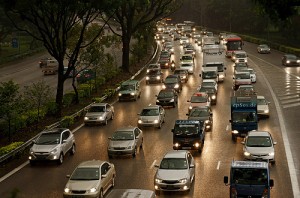Trying to avoid toxic chemicals? Take a survey of the different spaces you occupy every day. We've covered ways to reduce toxic chemicals in your home and in your office. Today we're covering another common space: Your car. Try these tips to reduce toxic chemicals in your car, and make your school drop-off, work commute, or errand-run healthier and safer.
Cars: Ever wonder what that "new car smell" came from? According to Rebecca Meuninck from the Ecology Center, "The “new car smell” is actually the smell of toxic chemicals being released from interior auto parts such as the seating, dashboards and vehicle trim." Yikes! HealthyStuff.org just released a new guide to toxic chemicals in cars, including their Top 10 Best and Worst Picks for vehicles. If you're in the market for a new car, visit HealthyStuff.org to learn more about the safest, least toxic cars on the market.
Open a window: Don’t worry, you don’t have to roll your windows all the way down during these wintery months. But when you’re in heavy traffic, Healthy Child Healthy World recommends cracking your window slightly to reduce carbon monoxide buildup inside your car.
Car Seats: Avoid flame retardants in car seats by choosing carseats that don't use polyurethane foam and that don't have a TB117 label. Some manufacturers state that their products do not contain halogenated flame retardants. Even with a safety promise, it’s a good idea to double check with the manufacturer before you buy. You can check chemical levels in carseats and more on HealthyStuff.org.
Headsets: When it’s time to make or take a call, use your hands free headset as much as possible: Headsets emit less radiation than cell phones. Check out EWG’s buying guide for cell phone headsets to help you find the safest headset with the least radiation.
Air Fresheners: Look, we all want a delightful, fresh-rain-new-laundry-mountain-whatever smelling car. But air fresheners are not the way to go when it comes to keeping your indoor air smelling fresh. While improving the indoor air scent, air fresheners also contribute to indoor air pollution and often contain phthalates, galaxolide, and tonalide.
Make an easy, DIY air freshener instead! How It Works has this easy solution for a homemade car air freshener using your favorite essential oil. Or try a simple sachet: Treehugger has a simple tutorial on creating a lavender sachet.
Coffee & Water On-the-Go: Skip the plastic water bottles! Those convenient plastic bottles create 1.5 million tons of plastic every year. Also, the plastic may leech endocrine disruptors, which are linked to early puberty, infertility, and obesity. Invest in a reusable water bottle. The Daily Green recommends choosing an aluminum bottle with a water-based, non-toxic lining, and avoiding low-grade stainless steel bottles, which can leach metals. The same rules apply to purchasing a reusable coffee mug. Reusable coffee mugs are earth friendly, and budget friendly: Many coffee shops will offer free refills or discounts if you bring your own cup.




The views and opinions expressed in this post are those of the author(s) and do not necessarily reflect those of MomsRising.org.
MomsRising.org strongly encourages our readers to post comments in response to blog posts. We value diversity of opinions and perspectives. Our goals for this space are to be educational, thought-provoking, and respectful. So we actively moderate comments and we reserve the right to edit or remove comments that undermine these goals. Thanks!